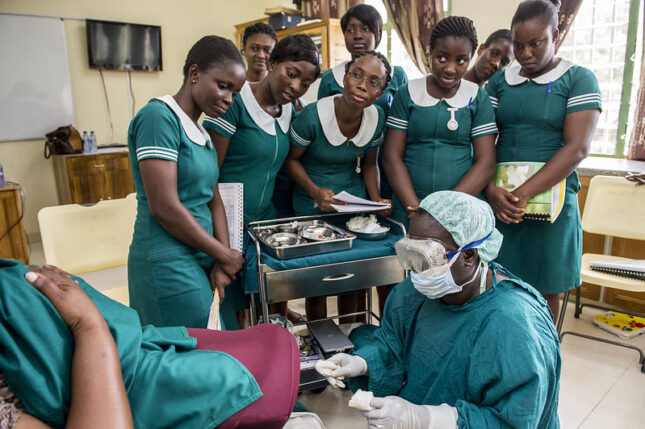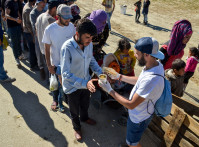-
2024 Dot-Mom Guest Contributor Highlights
January 15, 2025 By Maternal Health Initiative Staff
The Dot-Mom column of the Environmental Change and Security Program’s New Security Beat blog serves as a platform for diverse perspectives and insights from global experts in maternal and global health, gender equality, and peace and security. In 2024, the Dot-Mom column, hosted by the Wilson Center’s Maternal Health Initiative, was marked by an incredible number of guest contributor articles.
At the start of the year, Rachel Hall-Clifford and Gary Clifford wrote about the opportunity to use the collaborative process of co-design to revolutionize maternal health in their article, AI in Community Care: Can Co-design Shift the Balance in Maternal Mortality? Co-design centers the needs of end-users in all stages of innovation development. Safe+natal, is an example of a co-designed intervention to improve maternal health outcomes supported by the authors. Safe+natal is a perinatal monitoring toolkit and program used to detect fetal development that has been found to be particularly beneficial for groups who have historically faced racism and/or violence when accessing health services. Safe+natal was developed in partnership with Maya midwives in Guatemala and its user-interface was developed by the midwives to support use by Kaqchikel Maya speakers.
Despite global progress over the last 20 years, maternal deaths are on the rise across the Americas. In honor of the International Day of the Elimination of Racial Discrimination, Patricia Da Silva highlighted the disproportionate risk of maternal death that women and girls of African descent face during childbirth in Maternal Health: How Racial and Gender Discrimination Drive Maternal Mortality Rates. Da Silva presented findings from UNFPA’s 2023 analysis on disparities in health outcomes for Afrodescendent women and girls. Addressing these disparities involves improving data collection, including Afrodescendant women and girls at the decision-making table, and addressing the barriers they face in seeking care.
May 5th marked the International Day of the Midwife, with this year’s theme focused on midwives as a vital climate solution. Pandora Hardtman, Esther Bander, Rosemary Ngougu, Eugenia Mensah, and Angeline Houman shared their vision of the role of midwives in climate resilience in Q&A: Midwives as a Vital Climate Solution. Across Zambia, Kenya, Ghana, and the Ivory Coast, midwives have deployed innovative strategies to reach women during pregnancy in the midst of climate-related disasters. Empowering a resilient health workforce with midwives as first contacts for maternal health care can improve universal health coverage through reductions in environmental impacts, as well as more efficient, less costly health systems, and stronger local economies.
In October, Torunika Roy highlighted the South Korean government’s efforts to address its continuous drop in fertility rates since 2015 in “Too Many” to “Too Few”: South Korea’s Declining Fertility Rates. Roy attributes the cause of declining fertility rates to patriarchal norms, gender inequality, high costs of living, child-rearing challenges, increased education for women, long working hours, and a double caregiving burden for women to care for both children and older populations. While the South Korean government has sought to address these causes, such policies have been implemented without women’s input, necessitating a shift from policies meant to encourage numbers of children born to polices that address gender inequality, the care burden, and work-life balance.
And lastly, in her article Obstetric Violence in Sub-Saharan Africa: The Struggle for Dignified Maternal Care, Prudence Mutiso wrote about obstetric violence, which remains a pervasive, yet underreported issue in maternal health care across Sub-Saharan Africa. Mutiso highlighted the story of Josephine Manjani, a mother of three in Kenya who endured a harrowing birth experience. Across countries in the region, intersecting systemic challenges and insufficient accountability allow obstetric violence to continue unchecked and unpunished. Tackling obstetric violence involves introducing reporting mechanisms in hospitals, comprehensive research, and mandatory training on respectful and dignified maternity care.
We, at the Maternal Health Initiative, look forward to sharing more expert voices in 2025.
- AI in Community Care: Can Co-design Shift the Balance in Maternal Mortality? by Rachel Hall-Clifford and Gary Clifford
- Maternal Health: How Racial and Gender Discrimination Drive Maternal Mortality Rates by Patricia Da Silva
- Q&A: Midwives as a Vital Climate Solution by Esther Bander, Rosemary Ngogu, Eugenia Mensah, Angeline Houman, and Pandora Hardtman
- “Too Many” to “Too Few”: South Korea’s Declining Fertility Rates by Torunika Roy
- Obstetric Violence in Sub-Saharan Africa: The Struggle for Dignified Maternal Care by Prudence Mutiso
The Dot-Mom column is part of the work of the Wilson Center’s Maternal Health Initiative, which focuses its efforts at the intersection of global health equity and gender equality and their connections to U.S. foreign policy and programming. If you would like to be a guest contributor to the Dot-Mom column on New Security Beat, please send an email of interest with a short (150 words) pitch to mhi@wilsoncenter.org. Please put “Dot-Mom Pitch” in the subject line.
Photo Credit: Midwife Charity Mote advises students through a simulated birth process in Ghana. MCHIP/Karen Kasamauski, flickr.com. CC BY-NC-ND 2.0.
 A Publication of the Stimson Center.
A Publication of the Stimson Center.







